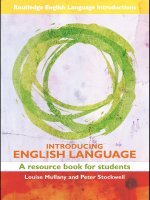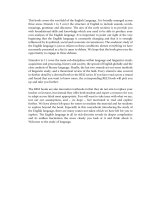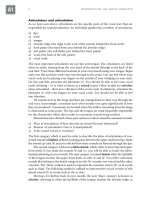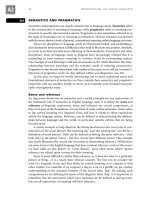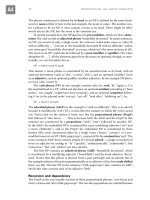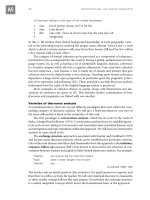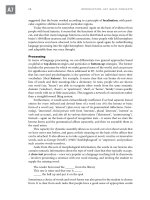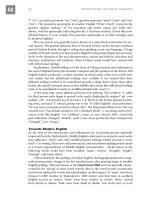Introdungcing English language part 10 pot
Bạn đang xem bản rút gọn của tài liệu. Xem và tải ngay bản đầy đủ của tài liệu tại đây (322.42 KB, 6 trang )
40 INTRODUCTION: KEY BASIC CONCEPTS
the internet and therefore the dominant form of all different types of computer-
mediated communication. Academic courses and degree programmes devoted solely
to World Englishes have also emerged, along with numerous publications on the topic.
The term World Englishes can thus legitimately be seen as a sub-disciplinary area of
English language enquiry in its own right.
The ‘circles’ model
In the 1980s, Braj Kachru (1986), now commonly perceived as the most influential
global figure in the field, produced a framework for conceptualising World Englishes.
This has proved to be the most influential approach which researchers use as an entry
point to studying World Englishes. Kachru argued that instead of thinking about ‘English’
in singular form, the language should be seen as a pluralised concept. The socio-
linguistic make-up of the whole range of different types of Englishes around the world
should be perceived as belonging within one of three concentric circles, which he termed
the Inner, Outer and Expanding circles.
The Inner Circle refers to the UK, Canada, the United States, New Zealand and
Australia, where the English language has its linguistic basis and where it is associated
with longevity, tradition and culture. This inner circle loosely corresponds with the
acronym ENL, English as a Native Language. The Outer Circle refers to contexts where
English has become an official language due to colonisation, which Kachru maps onto
the category of ESL: English as a Second Language. Examples of this include Nigeria,
Singapore, Malaysia and India. Finally, the Expanding Circle refers to situations where
English is used as a foreign language, commonly referred to as EFL contexts.
Prototypical examples of the third circle are the use of English in China and Japan
(see D10 for further details on Kachru’s model).
World Englishes should thus be viewed as a collective, all-encompassing term which
includes all of these different circles. Kachru’s model of multiple Englishes poses a
range of complex questions, especially when we are considering issues surrounding
the teaching of the English language. These issues gain further prominence when viewed
in light of the fact that for well over a decade now it has been consistently reported
that there are more ‘non-native’ English speakers than there are native speakers in
the world. Barbara Seidlhofer (2005) reports that the majority of interactions which
take place globally in English do not involve native speakers and thus English is being
moulded and developed by non-native speakers just as much as it is by native
speakers.
Roughly one-third of the world’s population now speaks English. So, pertinent
questions such as which English(es) should be taught, who should learn them and
who should teach them are currently being hotly debated by academics, practitioners
and policy makers world-wide.
English as a lingua franca
One important area of study for World Englishes which is becoming an increasingly
popular topic of investigation is how English operates as a lingua franca, most
simply defined as a common language. The need for a lingua franca arises when indi-
viduals who speak different, mutually unintelligible languages come into contact with
one another. English has become the world’s lingua franca, and the acronym ELF (English
WORLD ENGLISHES 41
as a Lingua Franca) is now frequently used. Speakers from any of the three circles,
including native speakers, can engage in ELF communication.
Examples of English fulfilling the role of a lingua franca can be found in various
locations around the globe. For example, South Africa has 11 official languages, but
English operates as the country’s lingua franca, functioning as the language of busi-
ness, government, and the mass media. Across Asia, English operates as a lingua franca
in numerous countries, including Malaysia, Singapore, Thailand, and Indonesia.
English is also the most common lingua franca in Europe. While there is variation in
terms of the positioning of English within individual European countries, English is
the lingua franca imbued with the most importance: more individuals learn English
in Europe than all of the other European languages put together. The European
Parliament has 23 official languages, but English is the one most commonly used.
English as a lingua franca in Europe can be observed in action in the following
report of a short yet revealing interaction which took place in the Czech Republic. In
an overheard conversation while quietly sipping a Budweiser Budvar beer in a café in
Old Town Square, Prague, one of your book’s authors observed a group of Spanish
native speakers approach one of the Czech waiters. The group were engrossed in con-
versation (in Spanish) and were deciding on nominating one of their group members
to ask the waiter for directions to the famous Charles Bridge. One woman eventually
came forward and immediately code-switched from Spanish into English, thus select-
ing English as the perceived common language in order to communicate with the waiter:
Tourist: Excuse me where is Carlos Bridge?
Waiter: Straight on then turn left at the corner and follow to the river
Tourist: Thank you
In the tourist’s initial utterance one lexical item, the proper noun ‘Carlos’ from her
native language, was still present. It is clear from the waiter’s response that this ‘splicing’
together of language varieties, known in sociolinguistics as code-switching, had not
hampered his understanding – the conversation was completed with all relevant
information disseminated.
When English is operating in the role of lingua franca, from the perspective of
pragmatics Firth (1996) has argued that there is a ‘let-it-pass principle’ in operation:
providing that conversationalists can basically understand each other they will let any
mistakes pass without comment, in an effort to communicate effectively, in a manner
that displays consensus and co-operation.
However, despite the successful nature of the above encounter in terms of infor-
mation dissemination and maintainance of co-operation and consensus between
speakers, this did not prevent an aside from a British woman at a nearby table to her
companion once the interaction had finished who clearly would not ‘let-it-pass’, even
though she had played no part in the conversation apart from being another over-
hearer. She rather sarcastically commented the following: ‘Funny that I thought it was
Charles Bridge not Carlos Bridge. Who’s this Carlos?’
This British woman’s comment, and the rather snide laughter that followed from
her and her interlocutor, can arguably be seen as a prime example of native-English-
speaker monolingual superiority and a negative attitude towards code-switching.
The sharp-eared waiter could not resist responding to this and took great delight in
42 INTRODUCTION: KEY BASIC CONCEPTS
informing the woman (in English of course) that Charles Bridge is actually called ‘Karlîv
Most’ in his country’s native language.
This brief example illustrates a range of sociolinguistic issues surrounding World
Englishes, including insights into language attitudes and stigmatisation associated with
code-switching, the maintenance of the pragmatic rules of co-operation by two ‘non-
native’ ELF speakers and the use of English as a successful lingua franca.
Standardisation of World Englishes
There has been common agreement amongst many World Englishes academics that
the increases in the usage of English as a lingua franca within Europe will lead to the
future establishment of a variety of ‘Euro-English’, and that such a ‘Euro-English’ could
well undergo the process of standardisation (see Kirkpatrick 2007). For a variety
of any language to become standardised it needs to undergo some process of
codification: to be officially recorded. A common manner in which language varieties
are codified is through the publication of dictionaries and grammar books. Therefore,
it is predicted that in future years dictionaries and grammars of a World Englishes
variety known as ‘Euro-English’ may well appear.
Once a variety of a language has been codified, norms of usage become established
from these sources of authority. A standard language variety can then be formally taught,
in part, by drawing upon these resources. In order for World Englishes to ever be prop-
erly recognised, varieties need to undergo some process of codification. Codification
is often considered to be the most powerful mechanism to enhance the status and
prestige of World Englishes varieties. Dictionary publication is crucial in demonstrating
that a variety has become properly institutionalised.
The process of codification is the most effective way of cataloguing descriptions
of different, emergent varieties of English. In particular reference to English as a
lingua franca (though this is a point that applies equally to all World Englishes
research), Seidlhofer argues that one key principle which should be accepted by
researchers is acknowledgement of the need for detailed description and then
codification. The cataloguing of descriptions would create a highly useful and much-
needed source so that knowledge of the linguistic features, including phonological,
lexical, grammatical, discoursal and pragmatic features that constitute different vari-
eties of English, can be shared.
However, it is important to highlight that, once a standard variety develops
and undergoes codification, this does imbue this one variety with prestige at the
expense of all other varieties, which will become stigmatised variants in comparison.
The standard variety is the one that has the most social, political and economic
power attached to it. The standardisation process places an uncomfortable control
upon the natural process of language evolution. As emphasised in the previous unit,
variations and changes are a completely usual and expected part of the life course
of any variety of language, be it a newer variety of English, such as those in the
outer and expanding circles, or any other variety of English circulating in the inner
circles.
Therefore, despite the advantages of codifying particular varieties, it is important
to bear in mind that fixing a language goes against its natural evolution. Any stan-
dard variety that has been selected by appropriate authorities is not inherently more
SWIN|KCrEIB1Qqc8svpQueSEh0w==|1282035786
STYLISTICS 43
complex, ‘correct’ or ‘pure’ – it is simply the version that has been imbued with the
most societal power and prestige.
So, how many different types of World Englishes dictionaries are there, and when
did they first emerge? World Englishes researcher Kingsley Bolton (2006) reports that
the first was Webster’s Dictionary, published at the beginning of the nineteenth cen-
tury (1806) in the United States, followed by a revised and expanded version in 1826.
Further versions of American dictionaries were also published during the twentieth
century. The first Canadian dictionary was published in 1967, but this has been replaced
by publication of the Canadian Oxford Dictionary in 1999; Australia had its first dic-
tionary in 1981, entitled The Macquarie Dictionary, and a New Zealand dictionary first
appeared in 1997.
India has a history of glossary and word-list publications dating back to the late
nineteenth century but as yet does not have an official national dictionary. The
Caribbean has twentieth century dictionary publications of Jamaican English and
Bahamas English and a dictionary of English usage published in the late 1990s, but
no national dictionary. No other World Englishes varieties as yet have any fully fledged
dictionary publications, though there are projects under way to produce dictionaries
for East Africa and South-East Asia.
It is immediately noteworthy that the fully fledged codification examples of
national dictionaries are from the most established, inner circle countries of the United
States, Canada, New Zealand and Australia. The only other countries which have had
(non-national) reference works published are outer circle varieties which, like the United
States, Canada, Australia and New Zealand, have a lengthy history of English usage
through colonisation: English was first introduced in the early seventeenth century in
the Caribbean and India. The use of English in these outer circle geographical loca-
tions thus has much longevity and, like its former colony counterparts in the inner
circle, English has had the status of an official language in these countries for a con-
siderable period of time.
Publication of national dictionaries is a part of a country’s independence process
and clearly demonstrates an official, separate identity from the former coloniser. It is
arguably more clear-cut to do this in post-colonial situations than in newer situations
such as Europe or South-East Asia, where English is used as a lingua franca by speakers
across many different nations. These codification issues will be further discussed
in B10.
STYLISTICS
All texts, whether spoken or written, display style, which can loosely be defined as the
recognisable linguistic and discoursal patterns in the text. Since every sound, word,
syntactic structure, co-referential link and overall shape of the text exists as a con-
sequence of choice (even if that choice is not highly conscious within the constraints of
the language system), style can be regarded as a set of choices. Those choices are significant
rather than merely ornamental: comparing the actual form of expression of a text with
A11
SWIN|KCrEIB1Qqc8svpQueSEh0w==|1282035789
44 INTRODUCTION: KEY BASIC CONCEPTS
any of the other numerous possibilities in which it could have been realised quickly
reveals differences in meaning, different emphases of meaning, different tones and evalu-
ative shading, different perspectives and different senses of emotion, commitment
and value. In other words, although it has been convenient in the past to separate form
(the linguistic patterning as structure) and content (its interpreted meaning), in prac-
tice form and content are indivisible.
The discipline of stylistics explores the relationships between language patterns
and interpretation. Though stylisticians examine the whole range of texts in the world,
stylistics has a particular interest in literary works, as the most prestigious examples
of language use.
Style as choice
For example, imagine in a literary text a person contemplating whether it would be
a good idea or not to commit suicide. The crux of this person’s existential dilemma
can be articulated in a variety of ways:
q ‘Should I kill myself or not?’ Here, a self-oriented interrogative is framed as a moral
imperative in the foregrounding of the modal ‘should’, and the act of suicide is
rendered semantically as a killing. The realisation of ‘kill’ and the negation and
elision of its contrary (‘or not’) places the act of killing in the foreground – the
opposite version would be something like ‘Should I carry on living or not?’
q ‘Euthanasia is an option for me.’ Here, the lexical choices are much more formal
and emotionally distanced, which is rather odd given the subject-matter. The
dilemma is cast in a declarative form rather than as a question.
q ‘There’s no point in going on!’ Here the choice is more exclamatory than the last
example, and here it captures direct speech more closely (the elided ‘There’s’, the
informal lexical choices, and the graphology of the exclamation mark).
Furthermore, the grammatical form begins with an existential ‘There’, which is
ironically apt in the circumstances. The negation is by the particle creating a neg-
ative noun-phrase (‘no point’) rather than by a verb-negation (‘There isn’t any
point . . .’), which is less negative than this alternative. Equally, the choice of
living or dying is positively framed (‘going on’) rather than negatively (something
like ‘ending it all’). The sentence also draws on a conventional metaphor in which
Life is cast figuratively as a Journey, and the end of life by extension is an end of
motion: here this finality is captured also by the sentence ending with a strongly
final closing exclamation mark.
There are many other possible ways in which this dilemma could be articulated. In
Shakespeare’s Hamlet, most famously, it is cast as follows:
q ‘To be, or not to be, that is the question.’ Here, the action of self-killing is abstracted
into an existential verb – the copula ‘to be’ – which itself is presented non-finitely,
without a grammatical subject. The existential state is foregrounded by the rever-
sal and clefting of the usual order of the sentence, which might normatively be
regarded as ‘The question is to be or not to be’. There is no self-reference, no per-
sonal pronoun, no subject expressed at all, except implicitly in the speaking voice.
This is a speaking voice, of course, placed in the mouth of the actor playing Hamlet
STYLISTICS 45
on a stage. All the utterances around this line are in a regular metrical pattern – an
iambic pentameter – with five repetitions of the iamb (an unstressed, then a stressed
syllable). In this line, though, the established pattern is disrupted. In the first six words,
‘ be, not be’ take the stress as you would expect, but few actors sustain the
pattern by stressing ‘is’ rather than ‘that’ (though either is a reasonable intona-
tional option). This begins to undermine the certainty of the metrical patterning already
established. Furthermore, there is an extra syllable at the end of the line (making
an odd 11 syllables rather than the normative 10), giving the effect of a weakly
trailing sense of bathos and indecisiveness to the line and undermining the clear
rational articulation that the speaker seemed to start with. Finally, like the second
example of the line above, the speaker chooses a form that distances him from the
action of suicide. Like the third example above, and contrary to the first example,
the positive (‘To be’) is placed more prominently than the negative and derivative
form (‘not to be’), which shades the statement marginally positively overall.
It should be clear how it is possible to connect these close stylistic observations of this
single line with significances of characterisation, theme and motive in the play as a
whole, especially if placed within a longer analysis of the entire speech that follows.
This is the basic craft of the stylistician.
Of course there are complications to be considered. One difficulty for stylistics is
that the literary text does not present all of the alternative versions that were poten-
tially available, as we have rather more usefully done above. Unless numerous drafts
and revisions of a writer’s manuscript exist, the literary work is singularly what it is.
Furthermore, if the subject-matter is fictional, or even articulated with poetic licence,
there is not in fact any pre-existing event that can be regarded as giving rise to the
linguistic articulation: the language is the event.
Of course, the exercise we have sketched out above allows a comparison of the
possible alternatives that were not taken to illuminate the choices that actually were
taken by the writer. This creative intervention as an analytical method is a useful one
for the stylistician. And the fact that there is no pre-existing version of a literary arti-
culation is of course actually a powerful argument for the significance of analysing the
language of the literary text in detail and professionally.
Style as patterning
It should also be apparent in the very brief stylistic analyses above that an important
concept in stylistics is the notion of prominence or foregrounding. Texts are not even;
some parts are more noticeable than others. This unevenness of texture is a con-
sequence of different linguistic choices, it underlies the existence of style itself, and it is
what allows stylistics its validity and power. Foregrounding depends on a sense that
the particular feature that you have noticed is doing something noticeably different
from the previous co-text or from what you might ordinarily have expected in that
context. It thus relies on deviance or deviation from a norm. Of course, it is not
simple to specify exactly what that norm is – whether in the language system in general
or in the prior establishment of the literary work in particular or genre in general.
However, we can at least talk of characteristic patterns in texts that are recognisable
and available for analysis.

